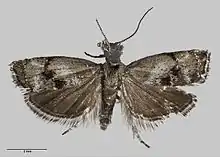Asterivora urbana
Asterivora urbana is a species of moth in the family Choreutidae.[1] It is endemic to New Zealand and has been observed in Arthur's Pass. Adults are on the wing in January.
| Asterivora urbana | |
|---|---|
 | |
| Scientific classification | |
| Kingdom: | |
| Phylum: | |
| Class: | |
| Order: | |
| Family: | |
| Genus: | |
| Species: | A. urbana |
| Binomial name | |
| Asterivora urbana (Clarke, 1926)[1] | |
| Synonyms[2] | |
| |
Taxonomy
This species was first described by Charles E. Clarke in 1926, using specimens taken at Arthur's Pass on the open mountain-side at 4,000 ft. in January.[3] Clarke originally named the species Simaethis chatuidea.[3] In 1928 George Hudson discussed and illustrated this species under that name in his book The butterflies and moths of New Zealand.[4] In 1979 J. S. Dugdale placed this species within the genus Asterivora.[5] In 1988 Dugdale confirmed this placement.[2] The male holotype specimen, as well as other specimens using in the naming of this species, are held at the Auckland War Memorial Museum.[2]
Description
.jpg.webp)
Clarke described this species as follows:
♂ ♀. 9 1⁄2 mm. Head fuscous with whitish scales. Palpi with whorls of white black-dotted scales with longer tuft beneath. Thorax bronzy-brown dotted with black and with longer scales. Legs dark fuscous irrorated with whitish. Antennae blackish annulated with grey. Abdomen dark fuscous, margins of segments grey. Forewings elongate, costa anteriorly arched, apex moderately obtuse, termen slightly rounded, oblique; dorsum gently oblique, rounded along inner half; bronzy-brown; a grey inwardly-oblique area at rather less than 1⁄2, distinct on dorsal side but obscurely reaching costa; a black transverse line at 1⁄2, convex outwardly with tendency to form about three dots across wing, outwardly bordered and dotted with metallic silvery markings; a bronzy-brown transverse area at about 3⁄4 crossed by grey, more definite towards dorsum; a row of metallic silvery dots at 4⁄5 transversely to reach tornus; outwardly and at apex of wing blackish: cilia grey with black basal and median lines with suffusion of dark fuscous at apex and anal angle, tips whitish. Hindwings dark fuscous, lighter on basal half: cilia grey with dark-fuscous basal and fuscous median lines, tips whitish.[3]
Distribution
This species is endemic to New Zealand and has been observed in Arthur's Pass.[1]
Behaviour
Adults of this species is on the wing in January.[4]
References
- Gordon, Dennis P., ed. (2010). New Zealand inventory of biodiversity: Kingdom animalia : chaetognatha, ecdysozoa, ichnofossils. Vol. 2. p. 457. ISBN 978-1-877257-93-3. OCLC 973607714. OL 25288394M. Wikidata Q45922947.
- John Stewart Dugdale (23 September 1988). "Lepidoptera - annotated catalogue, and keys to family-group taxa". Fauna of New Zealand. Department of Scientific and Industrial Research. 14: 114. doi:10.7931/J2/FNZ.14. ISSN 0111-5383. Wikidata Q45083134.
- Charles Edwin Clarke (12 July 1926). "New species of Lepidoptera". Transactions and Proceedings of the New Zealand Institute. 56: 420–421. ISSN 1176-6158. Wikidata Q63101109.
- George Vernon Hudson (1928), The butterflies and moths of New Zealand, Illustrator: George Hudson, Wellington, p. 307, LCCN 88133764, OCLC 25449322, Wikidata Q58593286
{{citation}}: CS1 maint: location missing publisher (link) - J. S. Dugdale (July 1979). "A new generic name for the New Zealand species previously assigned to Simaethis auctorum (Lepidoptera: Choreutidae), with description of a new species". New Zealand Journal of Zoology. 6 (3): 461–466. doi:10.1080/03014223.1979.10428386. ISSN 0301-4223. Wikidata Q54576372.